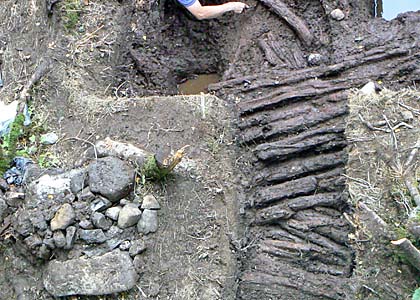2,700-Year-Old Iron Age Loch Village Discovered in Scotland’s Wetlands
During a small-scale dig, archaeologists discovered what was initially believed to be a crannog – a loch shelter, a loch-dwelling often found on the banks of a loch or sited on an artificial island.
Instead, they discovered at least seven houses built in wetlands around the now in-filled Black Loch of Myrton, near Wigtownshire, in south-west Scotland. Called a “loch village,” this type of site is unique in Scotland and there are few other comparable sites elsewhere in the British Isles.
Similar lake villages have been found in Glastonbury and Meare, both in Somerset, but this is the first loch village to be uncovered in the north of the Border.

Scotland’s Iron Age began some 2,700 years ago.
The Wigtownshire dig was a pilot excavation of what was thought to be a crannog, under threat by drainage operations.
However, during the excavation over the summer, AOC Archaeology Group – which worked on the dig in conjunction with local volunteers – discovered evidence of multiple structures.
During the dig, which was part-financed with £15,000 from Historic Scotland, archaeologists realized that what appeared to be a small group of mounds was a stone hearth at the center of a roundhouse.
The timber structure of the house has been preserved, with beams radiating out from the hearth, forming the foundation, while the outer wall consisted of a double-circuit of stakes.
Rather than being a single crannog, as first thought, it appears to be a settlement of at least seven houses built around the small loch. Crannogs were probably the centers of prosperous Iron Age farms, where people lived in an easily defended location to protect themselves and their livestock from raiders.
Nancy Hollinrake, who runs an archaeology business with her husband in Glastonbury and who is also on the committee of the Glastonbury Antiquarian Society, said she was excited by the find.

She explained that although there were hundreds of crannogs in Scotland, this was different.
“It says a lot about the degree of protection they would have needed – having that many crannogs in one area,” she said.
“The industry would have been iron – and they would have been able to get the temperature of a furnace up to a point where they could smelt iron and make glass,” she added.
“There would have been high levels of craftsmanship and exchange of goods.
“They would also have carried out enamelling, bronzework, as well as spinning, weaving and dyeing large amounts of cloth. They decorated braids and played games with dice.”
Graeme Cavers, of AOC Archaeology, who is the co-director of the site, said that because the land was abandoned after the Iron Age, the buildings were well preserved.
“Waterlogged wood also offers the opportunity to date the structure very accurately using dendrochronology – or tree-ring counting – to give a date accurate to within a few years or even months, rather than the decades or centuries usually provided by radiocarbon dating,” he added.




